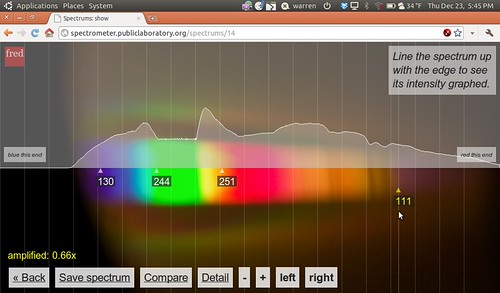Several Public Laboratory groups have emerged around the development of new tools for measuring contamination and quantifying ecologic issues. Among them is an informal spectrometry working group, which is attempting to create an inexpensive spectrometer.
Such an instrument offers the possibility of detecting and even quantifying contaminants such as polycyclic aromatic hydrocarbons, or PAHs — exactly the kind of toxic residue which has resulted from the BP oil spill, and identified in concentrations of up to 4.5 percent at the bottom of the Gowanus Canal in Brooklyn, N.Y.
While this is an ambitious and even speculative project, the idea that citizens could have access to affordable contaminant detection, and to perform their own investigations of risks to health and the environment, is attractive and powerful. I’d like to recount a bit about this process of development, in order to offer a glimpse of how Public Laboratory, a community which develops and applies open-source tools to environmental exploration and investigation, approaches civic science.
Spectrometry is a subject which I knew next to nothing about six months ago. Look on Google Shopping or Amazon for “spectrometer” and you’ll see why this is true for the average member of the public — prices for even the most basic instruments start around $2,500. Spectrometry books are esoteric, and publicly available research on the topic is hard to come by. (The struggle for open access to research is an interesting movement both for research publications and raw data.)
However, a blog post by students at the Inter-University Center for Astronomy and Astrophysics at Pune, India, showed a simple spectrometer constructed from a cardboard pizza box and a fragment of a DVD. By holding a camera up to the instrument, very high-resolution spectra can be photographed.
how it works
Spectrometry is a common tool for chemists attempting to identify an unknown material. They work by measuring the light which shines through a sample, splitting the light up into a rainbow of colors, and picking out the precise colors of light which have been absorbed. Molecules vibrate at distinct frequencies which interfere with light, and these unique absorption “fingerprints” can be used to match samples against a library of known spectra.
The Mars rovers Spirit and Opportunity each have a spectrometer onboard (albeit a different kind than ours), as does the Mars Express orbital probe (which is actually very similar to ours). These tools help them in the search for water, while here on Earth spectrometry has been used — even in the field — to detect contaminants, assess crops, and identify vegetation.
While the spectrometers we build are not yet good enough to detect anything but water vapor or colored dyes, we’re slowly getting better at building and using them.

Spectrometers at Escuelab.
How do we hope to improve these instruments, and to make them accessible and affordable? The first step is to build a lot of spectrometers, which we have done in a series of open-ended public workshops. Our first attempt was at an art/technology/society space called Escuelab, in Lima, Peru. With Nadya Peek of the MIT Center for Bits and Atoms and a small group of interested hacker-activists, we constructed a number of tube-shaped spectrometers for under $5 each, and took photos of spectra of items such as leaves, slices of pineapple, and flowers of varying colors.
The design was refined and tested at later public workshops in cities around the U.S., including a large “class” at the Whitney Museum in New York, part of the barter-for-learning program organized by a group called Trade School.

Spectrum of a pineapple slice.
Recent versions of the spectrometer use USB webcams, which are optimized for dimly lit dorm rooms or Internet cafes, and due to economies of scale, are cheaper than point-and-shoot digital cameras at $5 to $20 each. These allow for analysis in real time, and a connected laptop displays a continuously shifting graph of wavelength intensities. This spectrometry setup looks vaguely like a microscope, but it is made out of cardboard and hot glue.

A webcam-based video spectrometer.
Katie Gradowski and Will Macfarlane from the Somerville, Mass.-based DIY summer camp Parts & Crafts were so interested in the simple spectrometer design that they improved upon it and distributed a “PLOTS Spectrometer” kit to dozens of kids, including an illustrated guide and introduction to spectroscopy. Concerned that younger kids would not be interested, they designed their spectrometer to double as a kaleidoscope.
a spectral turntable
The idea that scientific instruments could have an alternative use for entertainment is a powerful one, and it inspired us to create a “spectral turntable” in a subsequent workshop with Parts & Crafts campers. This used a spinning clear disc placed on an actual record player — stylus swapped for a spectrometer, so that “samples” (pun intended) placed on the disc would be read cyclically as the turntable rotated. The readings were converted into an audible “beat,” but more importantly, the use of the turntable to generate music hones the same skills which will be important to identifying materials — sample preparation, calibration, and comparison of the results.
We’re slowly getting better at each part of the process — doing our best to share and invite others to collaborate, and to continue looping back to the original problem of identifying contaminants. The Parts & Crafts workshop was an excellent opportunity to build expertise in sample preparation, and we soon hope to set up publicly accessible spectrometers in sites around the Gowanus Canal and to organize a group sample-collection and analysis session to begin to identify PAHs.
We may not succeed at first, and we can use all the help we can get — join the Public Laboratory site/mailing list, or contact us at [email protected] to get involved!
Escuelab image courtesy of Nadya Peek.

